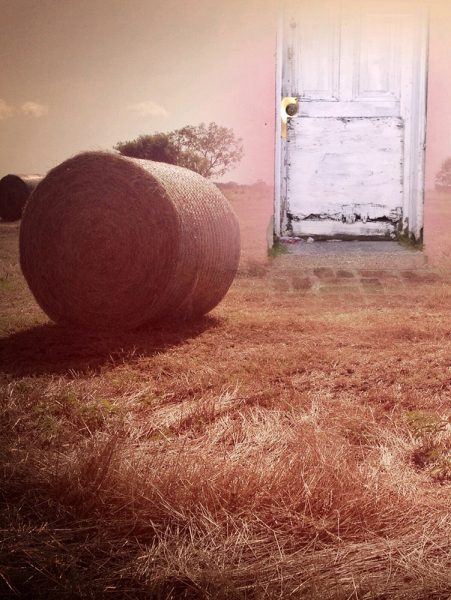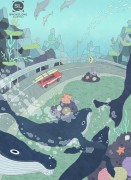One of the things I love most about “Gun” is how quietly tension builds. It’s almost hidden beneath a plethora of writerly tools: humor, sarcasm, banter, and even sensuality—to a point. But it emerges near the end as the leading player. How did this story find its shape?
Shape! Shape is tricky! I often think about writing as the collecting of threads; threads can braid, they can ball up, they can be separate and parallel, separate and perpendicular. With “Gun”, there was kind of a woven texture: a thread of physical action / time, a thread of character (hesitancy and coercion), and a thread of conversation / metaphor. I tried to keep each of these nipping over and under and through one another, and I think it’s toward the end that the weave tightens and they begin to bump up against one another, and that’s (hopefully!) where the tension comes from. The character I think of as the narrator begins the story in a place of discomfort. He’s being invited into a situation he doesn’t want to be in, but it’s only once the conversation turns to pronouncements about his turf of creativity, and he’s told to handle the gun, that his discomfort really begins to manifest in earnest.
I often find that in writing flash fiction, it arrives fully formed, fully developed—which is not the case at all for me when writing longer fiction. Where did this story come from, and how does it connect to your other writing? Are there thematic similarities between this and your other work?
Yeah! I have that too, the wonderful fully-formed phenomenon. I find that a lot of my best flash stems from small moments that happen to me in real life, coincidences I can convince myself have the potential for metaphor or connection. With this story, it was actually several separate pieces that came together over time. The gun came first; I don’t remember where from, but it was always a Mosin-Nagant, which is a grandfatherly sort of gun: old, simple, and rugged. I have a strange relationship with guns. On one hand, I find their mechanical function, their cold complexity, fascinating and beautiful. On the other hand, guns are machines for killing. They have no other use. It was only when I encountered an art supply store over the summer (a very beautifully designed crisp and elegant store) that I realized I was having the same reaction—an object that was so intrinsically beautiful that it effectively deafened me to its use. And that got me thinking: would I draw differently holding a beautiful pen? Would it be any consolation to be killed by a beautiful gun? And I decided to have it out with myself.
As far as comparisons to my other work go, I would say the connection is more at the character level, although I do return to visual art as a vein to tap. The characters play out two models of masculinity: one that is aggressive, direct, visceral, and self-certain; the other of which is self-effacing, sensitive, intellectual, and passive. Watching these two types of characters, usually men, interact has become something I return to in writing. I think it’s also bound up with maturation, innocence vs. experience, and the like.
Masculinity, its place in our society, and its varieties, is such fertile territory to concern yourself with, particularly in relation to some of our current cultural conversations. I was struck by the implications this piece suggests. Is “Gun”, in some way, born of the times? Have you interrogated your interest in masculinity as a theme?
“Gun” is definitely a product of the political landscape. When I moved to Texas, I remember being struck by the gun culture there—the prevalence of shooting ranges and gun stores, for example. That was new to me. Gun legislation is an ongoing issue, and I remember carry laws pertaining to schools and public areas like parks and playgrounds being passed while I was living there. I’ve seen guns openly carried in Virginia too, where I live now. And while this conversation isn’t new, the carry laws do seem to create a certain forced interaction with guns that some of us aren’t used to. And of course gun politics are intersecting with identity politics in new ways. The surge in gun sales after President Obama was reelected, for example. And doesn’t that speak to masculinity in a way? An insecurity of certain brands of identity in the face of new(ish) challenges to binary ideals of gender, race, sex, and so on. I’m not a particularly masculine man, and so I’ve struggled a bit to locate myself in society as well. So thinking about writing from a position of spectrum over binary—maybe that’s where those things overlap for me.
Tell me about the decision to write this piece entirely in dialogue–another thing I love about it!
Thanks so much! It’s really gratifying to try something a little risky and have it land. Originally, I think I was going to have the piece be a sort of related anecdote, something like Jamaica Kincaid’s “Girl,” where we’re getting an extended monologue from one character, delivered through the lens of another. But as I was writing it, I just sort of put quote marks around it. Then it became conversation. There was definitely a link to what I was reading at the time as well. I was preparing the syllabus for an intro to fiction course I’m teaching now, and I was reading a lot of dialogue-heavy stories—Hemingway’s “Hills Like White Elephants” and Richard Bausch’s “Aren’t You Happy For Me?”, etc—and so that mode probably filtered through.
Three books, writers, or works of art that you return to in your writing.
Only three? Oh man …
I return to Color Field art quite a lot—Rothko, Motherwell, and the like. Street photography moves me deeply—Bresson, Koudelka, Kertesz, Erwitt, etc. In books, there are too many to name, but lately I’ve been obsessed with Maggie Nelson and JM Coetzee, a prototypically weird mix. I’d love to go on about music too, but then I’d be cheating … more than I already did.
Thanks a million! It’s been an honor and a privilege, as they say.



 The core workshop of SmokeLong Fitness is all in writing, so you can take part from anywhere at anytime. We are excited about creating a supportive, consistent and structured environment for flash writers to work on their craft in a community. We are thrilled and proud to say that our workshop participants have won, placed, or been listed in every major flash competition. Community works.
The core workshop of SmokeLong Fitness is all in writing, so you can take part from anywhere at anytime. We are excited about creating a supportive, consistent and structured environment for flash writers to work on their craft in a community. We are thrilled and proud to say that our workshop participants have won, placed, or been listed in every major flash competition. Community works.